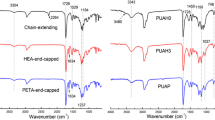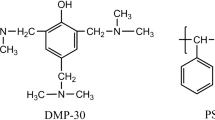Abstract
Nanocapsules with triethylene glycol dimethacrylate (TEGDMA) as core material and polyurethane as wall material used for self-healing bonding resin were prepared by interfacial polycondensation in miniemulsion. The influence of surfactant and costabilizer concentration on nanocapsules size and stability of nanocapsules was investigated. The size and its polydispersity of the nanocapsules were measured by light-scattering particle size analyzer. When the concentration of SDS were increased from 2.5wt% to 10wt%, the size decreases from 340.5 nm to 258.3 nm, PDI decreased from 0.210 to 0.111. As the concentration of HD increased, the size and PDI were both decreased, When reaching 10wt%, the size was 258.0 nm, PDI was 0.130. SDS and HD play important effect in synthesis of Nanocapsules containing TEGDMA. By changing the surfactant and costabilizer concentration it was possible to synthesize a wide variety of nanocapsules sizes. The performance and technical parameters of nanocapsules had been researched preliminarily, which built the solid foundation for the application to the self-repairing bonding resin.
Similar content being viewed by others
References
Van BM, Munck JD, Yoshida Y, et al. Adhesion to Enamel and Dentin: Current Status and Future Challenges[J]. Oper. Dent., 2003, 28(3): 215–235
Perdigao J. Dentin Bonding as a Function of Dentin Structure[J]. Dent. Clin. N. Am., 2002, 46: 277–301
Dry C. Procedures Developed for Self-repair of Polymeric Matrix Composite Materials[J]. Composite Structures, 1996, 35: 263–269
Motuku M, Vaidlfa UK, Janowski GM. Parametric Studies on Self-repairing Approaches for Resin Infusion Composites Subjected to Low Velocity Impact[J]. S mart Materials and Structures, 1999, 8: 623–638
Tay FR, Pashley DH. Dental Adhesives of the Future[J]. J. Adhes. Dent., 2002, 4: 91–103
White SR, Sottos NR, Geubelle PH, et al. Autonomic Healing of Polymer Composites[J]. Nature, 2001, 409(15): 794–797
Mainardes RM, Silva LP. Drug Delivery Systems: Past, Present, and Future[J]. Current Drug Targets, 2004, 5: 449–455
Goldberg M, Langer R, Jia XQ. Nanostructured Materials for Applications in Drug Delivery and Tissue Engineering[J]. J. Biomate. Sci. Polymer Ed., 2007, 18: 241–268
Mayer C. Nanocapsules as Drug Delivery Systems[J]. Int. J. Artif. Organs., 2005, 28(11): 1163–71
Landfester K, Bechthold N, Foster S, et al. Evidence for the Preservation of the Particle Identity in Miniemulsion Polymerization[J]. Macromol. Rapid Commum., 1999, 20: 81–84
Landfester K, Bechtold N, Tiarks F, Antonietti M. Formulation and Stability Mechanisms of Polymerizable Miniemulsions[J]. Macromolecules, 1999, 32: 5222–5228
Landfester K. Recent Developments in Miniemulsions-formation and Stability Mechanism[J]. Macromol. Symp., 2000, 150: 171–178
Kabalnov AS, Makarov KN, Pertzov AV, Shchukin ED. Ostwald Ripening in Emulsions: 2. Ostwald Ripening in Hhydrocarbon Emulsions: Experimental Verification of Equation for Absolute Rates[J]. J. Colloid. Interface. Sci., 1990, 138(1): 98–104
Webster AJ, Cates ME. Stabilization of Emulsions by Trappedspecies[J]. Langmuir., 1998, 14(8): 2068–2079
Reimers J L, Schork F J, Lauroyl. Peroxide as a Cosurfactant in Miniemulsion Polymerization[J]. Ind. Eng. Chem. Res., 1997, 36: 1085–1087
Author information
Authors and Affiliations
Corresponding author
Additional information
Funded by the National Natural Science Foundation of China (No. 30672346)
Rights and permissions
About this article
Cite this article
Guo, J., Pan, Q., Huang, C. et al. The role of surfactant and costabilizer in controlling size of nanocapsules containing TEGDMA in miniemulsion. J. Wuhan Univ. Technol.-Mat. Sci. Edit. 24, 1004–1006 (2009). https://doi.org/10.1007/s11595-009-7004-2
Received:
Accepted:
Published:
Issue Date:
DOI: https://doi.org/10.1007/s11595-009-7004-2




